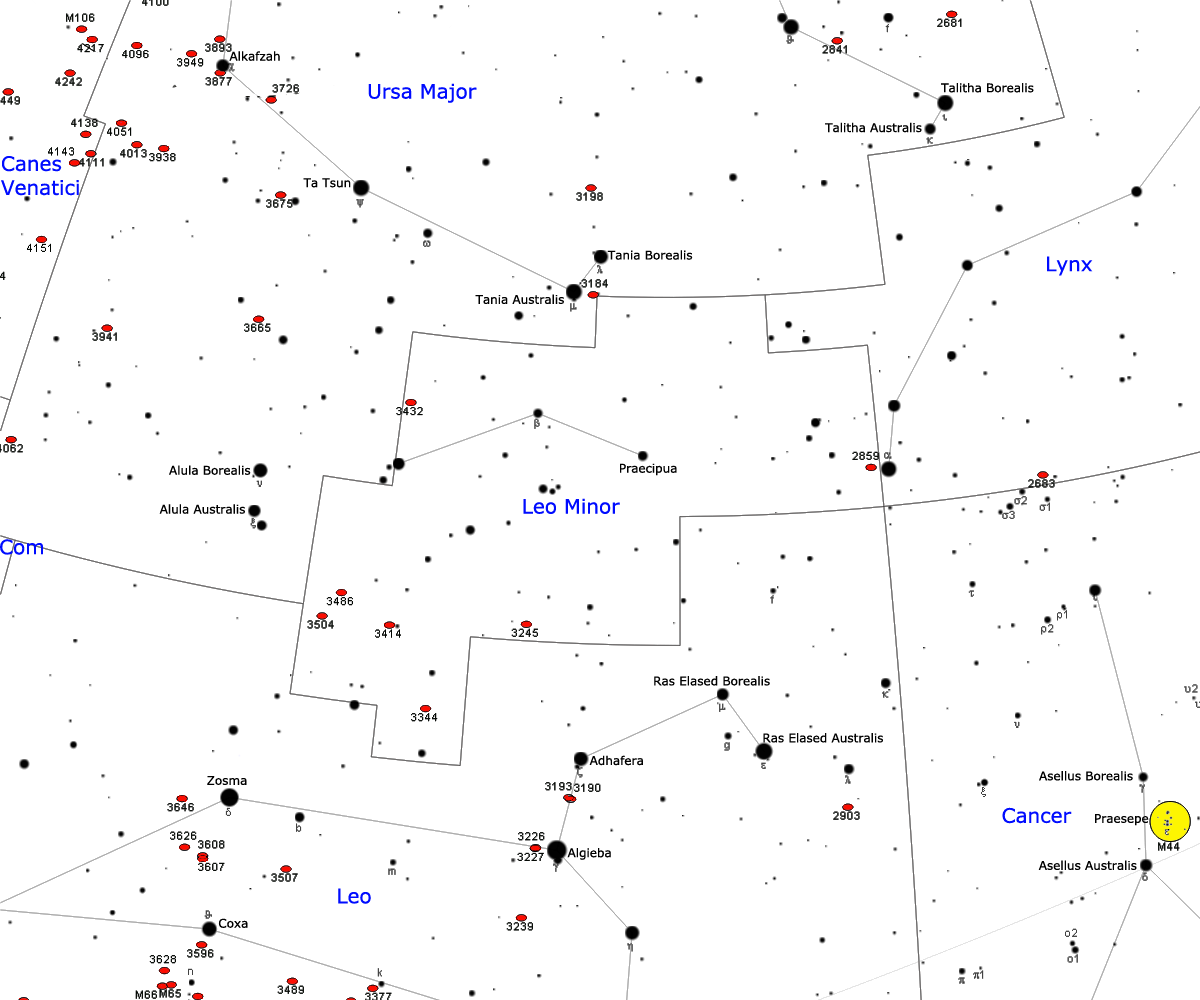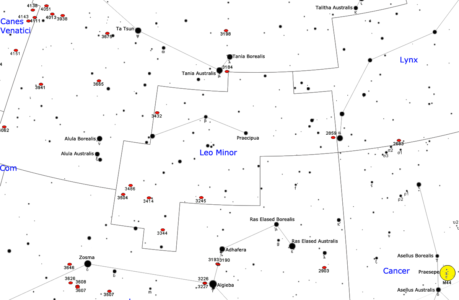The night sky has always fascinated humans with its beauty and mystery. Stargazing has been a popular pastime for centuries, with people from all around the world looking up at the stars and constellations that decorate the sky. One of these constellations is Leo Minor, a small but distinctive constellation that is easily visible from Ireland.
In this article, we will explore the constellation of Leo Minor and provide a guide on how to view it from Ireland. We will delve into the history and mythology behind this constellation, as well as the best times and places to view it in the Irish night sky.
The Constellation of Leo Minor:
Leo Minor is a small constellation located between the constellations of Leo and Ursa Major. It was first introduced by the Polish astronomer Johannes Hevelius in the 17th century. The constellation is named after the Latin term “Leo Minor,” which means “the smaller lion,” referring to its proximity to the constellation of Leo.
The constellation of Leo Minor is made up of five main stars, which form a backwards question mark shape. The brightest star in Leo Minor is 46 Leonis Minoris, which is also known as Praecipua. This star has a magnitude of 3.9 and is located approximately 95 light-years away from Earth. Other notable stars in the constellation include 21 Leonis Minoris and 24 Leonis Minoris.
Mythology and History of Leo Minor:
There is not much mythology or history associated with Leo Minor. However, its proximity to the constellation of Leo has led to some interesting stories. In Greek mythology, Leo was a powerful lion that was killed by the hero Hercules. It is said that Leo Minor was one of the lion’s cubs, which followed its father into the sky after he was killed.
In Chinese astronomy, Leo Minor was part of the larger constellation of the Black Tortoise. This constellation was one of the four symbols of the Chinese constellations and represented the north and the winter season.
Viewing Leo Minor from Ireland:
Leo Minor is visible from Ireland throughout the year. However, the best time to view it is during the winter months when it is highest in the sky. The constellation can be seen in the northeastern part of the sky, between the constellations of Leo and Ursa Major.
To view Leo Minor from Ireland, you will need to find a location with minimal light pollution. The best places to view the constellation are in rural areas away from the bright lights of cities and towns. It is also recommended to view the constellation on a clear night when there is minimal.
In conclusion, Leo Minor is a small but distinctive constellation that is easily visible from Ireland. Its proximity to the constellation of Leo has led to some interesting mythology and history. To view Leo Minor from Ireland, you will need to find a location with minimal light pollution and view it during the winter months when it is highest in the sky. We hope this guide has been helpful and that you will be able to enjoy the beauty of Leo Minor in the Irish night sky.
How can I see the constellation of Leo Minor from Ireland?
To see the constellation of Leo Minor from Ireland, you will need to find a location with minimal light pollution, as this will allow you to see more stars in the night sky. This can be achieved by going to rural areas away from the bright lights of cities and towns.
Once you have found a suitable location, you can begin to search for Leo Minor in the northeastern part of the sky, between the constellations of Leo and Ursa Major. The best time to view the constellation is during the winter months when it is highest in the sky. During this time, Leo Minor will be visible for most of the night.
To identify Leo Minor, look for a backwards question mark shape formed by its five main stars. The brightest star in the constellation is 46 Leonis Minoris, which has a magnitude of 3.9 and is located approximately 95 light-years away from Earth.
It is recommended to view the constellation on a clear night with minimal cloud cover, as this will allow for the best visibility. If you are using a telescope or binoculars to view Leo Minor, make sure they are properly aligned and focused to get the best view possible.
Remember to dress warmly and bring a blanket or chair to sit on, as stargazing can take some time and you will want to be comfortable while viewing the stars. Enjoy the beauty of Leo Minor in the Irish night sky!
The mythology of the constellation of Leo Minor
There is not much mythology associated with the constellation of Leo Minor, as it is a relatively small and obscure constellation in the night sky. However, its proximity to the constellation of Leo has led to some interesting stories.
In Greek mythology, Leo was a powerful lion that was killed by the hero Hercules as one of his twelve labours. According to the myth, the lion’s skin was so tough that it was impervious to arrows and swords. So, Hercules had to strangle the lion to death with his bare hands. After killing the lion, Hercules placed it in the sky as a constellation to honour its bravery and strength.
Leo Minor, which is located near the constellation of Leo, is said to be one of the lion’s cubs. According to one myth, after the death of the lion, its cubs followed their father into the sky to become constellations. Leo Minor is said to represent one of these cubs.
In Chinese astronomy, Leo Minor was part of the larger constellation of the Black Tortoise. This constellation was one of the four symbols of the Chinese constellations and represented the north and the winter season. In Chinese mythology, the Black Tortoise was a giant turtle that supported the world on its back and was associated with the element of water.
Overall, the mythology of Leo Minor is not as well-known or detailed as some of the other constellations in the night sky. However, its proximity to the constellation of Leo and its association with the lion in Greek mythology make it an interesting and noteworthy constellation to observe in the night sky.
The Stars in the constellation of Leo Minor
The constellation of Leo Minor is a small and faint constellation that is located between the constellations of Leo and Ursa Major. It was first introduced by the Polish astronomer Johannes Hevelius in the 17th century and is named after the Latin term “Leo Minor,” which means “the smaller lion,” referring to its proximity to the constellation of Leo.
Leo Minor is made up of five main stars, which form a backwards question mark shape. The brightest star in Leo Minor is 46 Leonis Minoris, which is also known as Praecipua. This star has a magnitude of 3.9 and is located approximately 95 light-years away from Earth.
The second brightest star in the constellation is 21 Leonis Minoris, which has a magnitude of 4.5 and is located approximately 128 light-years away from Earth. The third brightest star is 24 Leonis Minoris, which has a magnitude of 4.9 and is located approximately 280 light-years away from Earth.
The other two stars in Leo Minor are less bright and have magnitudes of 5.5 and 6.1. They are known as 30 Leonis Minoris and 31 Leonis Minoris, respectively.
In addition to these five main stars, Leo Minor also contains several other interesting celestial objects. One of these is the Leo Ring, which is a faint ring of hydrogen gas that surrounds two galaxies in the constellation of Leo. Another object is the NGC 3003 galaxy, which is a spiral galaxy that is located approximately 47 million light-years away from Earth.
Despite its small size and relatively faint stars, Leo Minor is an interesting and notable constellation to observe in the night sky. Its backwards question mark shape and proximity to the constellation of Leo make it easy to identify, and its interesting celestial objects make it a worthwhile target for observation through a telescope.
Deep sky objects visible in the Constellation of Leo Minor
Despite its small size, the constellation of Leo Minor does contain some interesting deep sky objects that are worth observing with a telescope or binoculars.
One of the most notable deep sky objects in Leo Minor is the Leo Ring. This is a faint ring of hydrogen gas that surrounds two galaxies in the constellation of Leo. The ring is believed to have been formed by a collision between the two galaxies, which caused gas and dust to be expelled into space. The Leo Ring is best observed using a telescope and a narrowband filter that isolates the light emitted by hydrogen gas.
Another interesting deep sky object in Leo Minor is the spiral galaxy NGC 3432. This galaxy is located approximately 50 million light-years away from Earth and is notable for its spiral arms and bright central region. The galaxy can be observed using a telescope and is best viewed under dark skies with minimal light pollution.
The galaxy NGC 3344 is also located in Leo Minor. This galaxy is similar in appearance to the Milky Way and is notable for its bright central region and spiral arms. It is located approximately 20 million light-years away from Earth and can be observed using a telescope or binoculars.
Finally, there is the globular cluster M92, which is located near the border of the constellations of Leo Minor and Hercules. This cluster is one of the oldest known globular clusters in the Milky Way galaxy and is estimated to be around 14 billion years old. It contains hundreds of thousands of stars and can be observed using a telescope under dark skies with minimal light pollution.
Overall, the constellation of Leo Minor may be small, but it contains some interesting deep sky objects that are worth observing with a telescope or binoculars. The Leo Ring, NGC 3432, NGC 3344, and M92 are all great targets for those interested in exploring the night sky.

